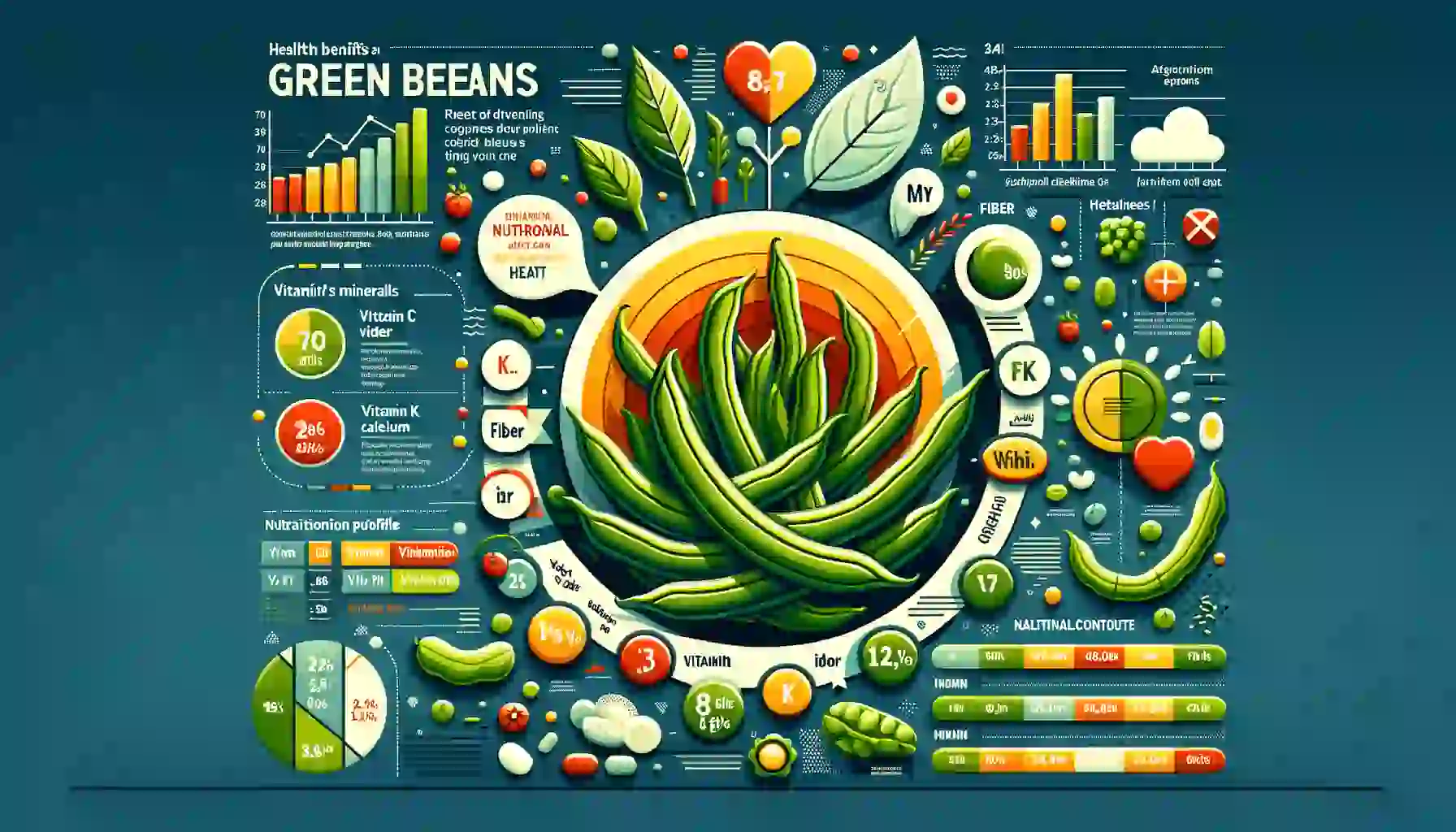Introduction:
Overview of Green Beans:
Green beans, often hailed as nature’s slender nutrient carriers, boast a rich history and a steady rise in popularity across the globe. Initially cultivated in Central and South America, these vibrant green pods have traversed continents, embedding themselves in a myriad of culinary traditions. Their adaptability to different climates and soils has made them a staple in gardens worldwide, from the sun-drenched fields of India, known locally as “fasol ki phali,” to the cooler, temperate zones of Europe and North America.
The importance of greenbeans in global cuisine cannot be overstated. They bring not just color and crunch to dishes but also a versatility that chefs and home cooks alike treasure. Whether blanched and tossed in a salad, stir-fried with spices, or simply steamed as a side, green beans have a way of complementing both the flavors and nutrition of meals, making them a beloved ingredient in kitchens around the world.
Health Benefits of Green Beans:
The nutritional value of green beans is both broad and impressive. These unassuming pods are low in calories yet rich in vital nutrients, including dietary fiber, protein, vitamins (notably Vitamin C and K), and minerals like iron, calcium, and magnesium. Incorporating them into any diet enhances overall health and well-being, making them a superb choice.
The impact of green beans on health extends beyond their nutritional composition. Their high fiber content aids in digestion and can help maintain a healthy weight by promoting a feeling of fullness. The antioxidants present in greenbeans, such as Vitamin C, help fight free radicals, reducing the risk of chronic diseases and supporting immune health. Additionally, the presence of folate makes them particularly beneficial for pregnant women, contributing to fetal development and reducing the risk of neural tube defects. Through these benefits and more, greenbeans emerge as a powerful ally in the quest for a balanced and healthy diet.
Nutritional Profile of Green Beans:

Green beans are a nutritional gem in the vegetable kingdom. These slender, green pods pack a wealth of nutrients essential for maintaining a healthy body. They’re not only delicious but also offer a variety of health benefits that can enhance our overall well-being. Let’s dive into the nutritional makeup of greenbeans and explore the benefits they bring to the table.
Macronutrients in Green Beans
Protein and Fiber Content: Green beans are a good source of protein and dietary fiber, making them an excellent addition to any diet. A serving of green beans can provide about 1.83 grams of protein and 3.4 grams of dietary fiber. The protein in greenbeans helps in the repair and growth of body tissues, while the dietary fiber aids in digestion and promotes a feeling of fullness, which can be beneficial for weight management.
Moreover, the fiber in green beans supports healthy bowel movements and can help prevent constipation. It also plays a role in controlling blood sugar levels, making greenbeans a smart choice for people with diabetes. Including greenbeans in our diet can contribute to our overall health by providing these essential macronutrients.
Carbohydrates and Fats: Green beans are low in calories and fats but rich in carbohydrates, offering a balanced energy source. They contain only 7.13 grams of carbohydrates per 100 grams, including dietary fibers and sugars. This low-calorie profile makes green beans an ideal food for those looking to maintain or lose weight without sacrificing nutrition.
The carbohydrates in greenbeans provide the necessary energy for daily activities, while the low fat content ensures that they can be a part of a heart-healthy diet. Integrating green beans into meals can help meet your energy needs while keeping calorie intake in check.
Vitamins and Minerals in Green Beans:
Key Vitamins: C and K: Green beans are a valuable source of vitamins, particularly Vitamin C and Vitamin K. Vitamin C, with 12.2 mg per 100 grams, is crucial for immune function, skin health, and collagen production. It acts as an antioxidant, protecting the body against free radicals and supporting overall health.
Vitamin K, on the other hand, is essential for blood clotting and bone health. With 43 µg per 100 grams, greenbeans can contribute significantly to our daily Vitamin K needs, ensuring that our body can heal properly from injuries and that our bones remain strong and healthy.
Essential Minerals: Iron, Calcium, and Magnesium- Green beans also boast a range of essential minerals, including iron, calcium, and magnesium. Iron is vital for the formation of red blood cells and the transportation of oxygen throughout the body. Calcium is known for its role in bone health and strength, while magnesium supports muscle and nerve function, as well as energy production.
By including green beans in our diet, we’re not only enjoying a tasty vegetable but also fortifying our body with these crucial minerals. This can help prevent deficiencies and maintain optimal health, from strong bones to a well-functioning muscular system.
Health Benefits of Green Beans:
Green beans, a vibrant and nutritious vegetable, are not just a colorful addition to your plate. They bring a multitude of health benefits, significantly supporting heart health and enhancing digestive wellness.
Supporting Heart Health
Green beans are a treasure trove for those looking to boost their cardiovascular health. Their fiber content is a key player in this arena.
Fiber and Cardiovascular Benefits: Firstly, green beans are rich in dietary fiber, a crucial element in lowering cholesterol levels. By integrating green beans into our diet, we’re taking a significant step towards reducing harmful LDL cholesterol. This process is vital because it helps to minimize the buildup of plaque in our arteries, ultimately reducing the risk of heart disease. Furthermore, the soluble fiber in greenbeans binds with bile acids in the gut, making our body use up cholesterol to replace them, thus lowering overall cholesterol levels.
Additionally, the presence of antioxidants in greenbeans helps in preventing oxidation of cholesterol, a precursor to heart disease. This makes green beans an excellent choice for maintaining a healthy heart.
Potassium and Blood Pressure: Moreover, green beans are a good source of potassium, an essential mineral that plays a critical role in managing blood pressure. Potassium helps to balance out the negative effects of salt in our diet and eases tension in our blood vessel walls, which can help to lower blood pressure. Regular consumption of greenbeans, with their potassium-rich profile, can contribute to cardiovascular health by maintaining a healthy blood pressure range.
Enhancing Digestive Health
Beyond heart health, green beans offer substantial benefits for our digestive system, primarily through their fiber content.
Dietary Fiber and Digestion: Dietary fiber in greenbeans aids in promoting regular bowel movements, which is essential for the prevention of constipation. This benefit is particularly important because it ensures the smooth passage of food through our digestive tract, making greenbeans a natural and effective solution for maintaining digestive health.
The fiber in green beans also adds bulk to our stool, which facilitates easier digestion and excretion. This process is beneficial for those looking to maintain a healthy digestive system.
Green Beans and Gut Health: Additionally, the fiber content in green beans serves as a prebiotic, nurturing the beneficial bacteria within our gut. A healthy gut microbiome is crucial for various aspects of health, including immune function and mental health. By supporting the growth of beneficial bacteria, greenbeans contribute to a balanced and healthy gut microbiome.
Green beans offer remarkable benefits for heart and digestive health. Their rich fiber content plays a vital role in lowering cholesterol, managing blood pressure, preventing constipation, and supporting a healthy gut microbiome. Incorporating greenbeans into your diet is a delicious and effective way to support overall health.
Green Beans in our Diet:

Incorporating green beans into our diet is a straightforward and tasty way to boost our nutrient intake. These versatile vegetables can be prepared in several ways, ensuring there’s a method to suit every palate.
Cooking Methods for Green Beans
Steaming and Boiling: Steaming green beans is a fantastic method to preserve their nutrients and vibrant color. It’s simple: just add them to a steamer basket over boiling water for a few minutes until they’re tender yet crisp. This method keeps the beans’ vitamins intact, offering us maximum health benefits. Similarly, boiling greenbeans in a small amount of water can also retain their nutritional value, provided us don’t overcook them. Both techniques ensure the greenbeans maintain their essential vitamins and minerals, making them a healthy addition to any meal.
Roasting and Sautéing: Roasting green beans brings out a delightful, caramelized flavor that’s hard to resist. Toss them with a little olive oil, salt, and your favorite seasonings, then spread them on a baking sheet. Roast in a preheated oven until they’re slightly crispy for a tasty treat. Sautéing is another great option. Quickly cook greenbeans in a pan with a bit of oil and garlic to enhance their natural flavors. Both methods add a delicious depth to greenbeans, making them a perfect side or main component.
Delicious and Healthy Green Bean Recipes
Salads and Side Dishes: Green beans shine in salads and side dishes, bringing freshness and crunch. Try mixing steamed greenbeans with cherry tomatoes, feta cheese, and a light vinaigrette for a refreshing salad. Or, combine them with almonds and lemon zest for a zesty side dish. These recipes are not only delicious but also pack a nutritional punch, making the most of greenbeans’ health benefits.
Main Courses Featuring Green Beans: Green beans can also star in main courses, adding texture and nutrition. Incorporate them into stir-fries with chicken or tofu for a balanced meal. Or, toss them in pasta dishes with parmesan for an extra veggie boost. These main courses are an excellent way to enjoy greenbeans’ versatility and make sure you’re getting a healthy dose of their fiber, vitamins, and minerals.
By exploring these cooking methods and recipes, you’ll find that greenbeans are not only nutritious but also deliciously adaptable to various dishes, making them a valuable addition to your diet.
Cautions and Considerations:
When adding green beans to your diet, it’s important to proceed with caution. Like any food, green beans may not suit everyone.
Allergies and Intolerances: Some people might experience allergies or intolerances to greenbeans. These reactions can vary in intensity from mild to severe. Symptoms include itching, hives, or gastrointestinal distress. If you notice any adverse effects after eating greenbeans, it’s crucial to stop consumption and consult a healthcare provider. They can help identify the cause and advise on dietary adjustments. Fortunately, green bean allergies are rare, but being aware is key to managing your health.
Proper Preparation and Consumption: Eating green beans raw might seem appealing for their crunch. However, it’s best to cook them to avoid potential health risks. Raw greenbeans contain lectins, which can cause stomach discomfort and interfere with nutrient absorption. Cooking greenbeans thoroughly reduces these compounds, making them safer and more digestible.
Moreover, moderation is essential. While greenbeans are nutritious, eating them in excessive amounts can lead to digestive issues due to their high fiber content. Aim to include a variety of vegetables in your diet to ensure balanced nutrition.
By being mindful of these considerations, you can enjoy the health benefits of greenbeans while minimizing potential risks.
Conclusion: Embracing Green Beans in our Meals
Green beans, a humble yet mighty vegetable, offer a treasure trove of benefits. Packed with essential nutrients, they stand out as a low-calorie source of protein, fiber, vitamins, and minerals. These nutrients promote heart health, aid in digestion, and support overall well-being. The fiber content helps maintain a healthy digestive system, while the presence of vitamins C and K, along with minerals like iron and calcium, boost immunity, strengthen bones, and enhance blood health. Incorporating greenbeans into our diet can contribute significantly to a balanced, healthful eating pattern.
If you’ve overlooked greenbeans, now’s the time to give them a chance. They’re not only nutritious but also versatile, fitting into any meal with ease. Whether steamed, roasted, or tossed into a salad, greenbeans add a fresh, flavorful touch to our dishes. Their health benefits, coupled with their culinary flexibility, make them a fantastic choice for anyone looking to enrich their diet. So, why not start exploring the many ways to enjoy green beans? Their addition to our meals can open up new avenues for both health and taste, proving that nutritious eating can also be delicious.
Also Read: Keto Diet: A Comprehensive Guide to Low-Carb, High-Fat Nutrition for Optimal Health









Thank you for your sharing. I am worried that I lack creative ideas. It is your article that makes me full of hope. Thank you. But, I have a question, can you help me?
Wow, incredible blog layout! How lengthy have you ever been blogging for?
you made blogging glance easy. The overall glance of your site is magnificent, let alone the content material!
You can see similar: ecommerce and here sklep online
Somebody essentially lend a hand to make significantly posts I might state That is the very first time I frequented your web page and up to now I surprised with the research you made to create this particular put up amazing Excellent job
I just could not leave your web site before suggesting that I really enjoyed the standard information a person supply to your visitors Is gonna be again steadily in order to check up on new posts